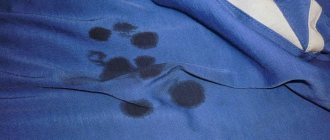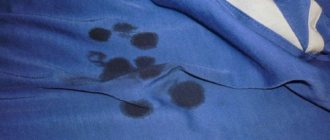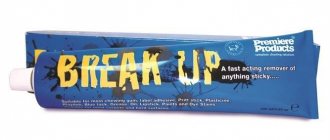Vegetable oil stains on fabric, especially on clothing, are an unpleasant occurrence. First of all, you need to remember that the faster measures are taken, the more reliable the result. There are several reasons for this. Firstly, oil has high fluidity and a drop of the substance on clothing tends to occupy the maximum area. Secondly, the oil tends to be oxidized by atmospheric oxygen and dry out, that is, at this time it goes through the polymerization stage, after which it will be extremely difficult, and sometimes impossible, to achieve complete purification. Dust begins to stick to the oil stain, causing even more contamination. The situation can be alleviated by the fact that sunflower oil is easily dissolved in organic solvents such as gasoline, kerosene, acetone or ethyl alcohol.
What can you do first?
Once the oil gets on the item, the main task is to prevent it from spreading. To do this, remove as much as possible: blot with a napkin, then sprinkle with any adsorbent (absorber).
Salt
Sprinkle generously in a thick layer and rub in gently. Remove after 10-20 minutes. If the mark does not disappear, repeat until you get the result.
Dish detergent
Any concentrate will do, since each contains components that break down fats. They pour it over the dirt and keep it for 15-30 minutes when it’s fresh, and longer when it’s dried. If the item can be washed, put it in the washing machine; if not, remove the gel with a damp cloth.
Dentifrice
Sprinkle the oil trail and rub in a little. Leave for 15-20 minutes, brush off, wash clothes. Apply a mixture of powder and water to the dried stain. Leave for 2-3 hours, then remove and wash the product.
Shaving foam
Shake the bottle and spray the foam onto the stained area. Wait 20-30 minutes, remove any residue, wipe the product with a damp cloth or wash it. If necessary, repeat the procedure.
General recommendations for removing stains
The main rule for how to easily remove a vegetable oil stain is to prevent it from spreading and setting. Next, degrease with a product suitable for the material and wash. However, if more than a day has passed, strong solvents and stain removers will be needed.
Test
In order not to ruin the item, before removing stains from sunflower oil, you need to try the product on the inside of your clothes or a spare piece. If the condition of the material has not deteriorated, you can begin to remove greasy marks.
Measure
When removing oil from clothes at home, it is important not to overdo it. Use only those products that are suitable for the type and color of the fabric, and keep it for the prescribed time. To prevent streaks from appearing, remove dirt moving towards the center from the edges.
Sources and nature of pollution
The most common sources of oil marks on clothing are cooking, cosmetic, and industrial oils (grease).
They leave bright, blurry spots that do not have a clear outline, which over time become covered with a layer of dust, fade and become dull. Old stains become visible on the reverse side of the fabric.
What material is stained?
You need to select cleaning products taking into account the characteristics of the material, since each product acts differently.
Jeans
The fabric quickly absorbs any liquid. As soon as a vegetable oil stain appears, you need to act immediately.
For light stains, dish gel and washing will help. If the stains are old, then before washing the clothes, they need to be degreased. Gasoline, kerosene, and white spirit are suitable for this.
Raincoat
The material does not tolerate high temperatures, so the cold method is indicated. Before washing off the oil, you need to degrease it with dishwashing detergent: pour in and leave for 1-2 hours. After the expiration of the period, wash off or wash (if allowed). For severe or extensive affected areas, soak clothes for 3-4 hours, then wash.
Knitwear
The composition of the material varies, so before you remove a sunflower oil stain from clothing, you need to study the label. Usually things do not tolerate high temperatures and aggressive substances. For cleaning, it is better to use gentle products, soaking, and washing.
Carpets and upholstery
Due to the impossibility of washing, local stain treatment is used. You can use any:
- shaving foam;
- carpet cleaner;
- soda, salt, talc;
- alcohol;
- water with vinegar.
Upholstered furniture can be easily cleaned with salt and alcohol. First, immediately sprinkle the stain with salt and rub in for about 3 minutes. When soiled, replace with fresh one. When the oil stops being absorbed, wipe with a cloth moistened with alcohol. Leave to dry.
Vinegar
- In a one-to-one combination, combine water and table vinegar.
- Rub the stained area with the resulting mixture.
- Wash the product.
Remember to take safety precautions when performing any type of oil stain removal work. Many available methods will help you remove fat from tissue, and you just have to choose the one that is most suitable for you.
The methods can be used individually, combined together, or applied sequentially in the presence of heavy old contamination.
Folk remedies
To deal with greasy stains, you don’t have to run to the store. You can find an effective remedy in the kitchen.
Baking soda
Sprinkle the affected area with baking soda and let it work for 15-30 minutes. Remove from the surface and finish cleaning the clothing in a suitable manner.
Mustard powder
The seasoning is recommended to remove greasy marks from dark and colored fabrics. Sprinkle fresh stains with powder, press into the fibers, hold for 20-30 minutes. Repeat treatment of stains from the inside out.
If there is a large area of fatty streaks, soak the product in mustard water. Dilute 200 g of powder in 10 liters of water, leave for 3 hours. Strain the solution, heat to 30-35 °C, soak clothes in it for half an hour, wash in the same water.
Glycerin with ammonia
Mix in equal parts and stir. Apply to the contaminated area. Leave on for 10-15 minutes, then rinse off. Wash the item.
Chalk
Helps in removing greasy stains from light-colored linen and cotton clothing. Before washing off the vegetable oil, rub crushed chalk into the stained area and leave for several hours. Process dark items from the inside out.
Mistakes to Avoid
In order not to harm the product by inept cleaning, you need to remember that when removing greasy stains you cannot:
- try to wash the fabric without first treating the contaminated area;
- use products that are not suitable for this type of fabric;
- use too hard brushes;
- dry the product in a machine without ensuring that the stain has been completely removed;
- Use colored cleaning products: dyes can damage the fabric being treated.
The problem of cleaning clothes from oil stains can be dealt with using an arsenal of numerous folk methods and household chemicals. By choosing from them those that are most suitable for a particular fabric, you can get rid of both fresh and stubborn dirt. If you still haven’t been able to remove the unattractive grease stain, you shouldn’t give up and say goodbye to your favorite item: in this case, you can resort to dry cleaning services.
Rate this post
What remedies will help deal with old stains?
You will have to work longer on stubborn fat. But they can also be dealt with if you use the right tools.
Vinegar
Prepare a liquid from equal parts of vinegar and water, moisten a cotton wool or disk in it, and press it onto the stain. Keep for 15 to 20 minutes.
Petrol
Before cleaning, slightly moisten the stain and place a paper towel, cotton wool or cloth under it. Mix gasoline with potato starch to form a paste. Apply, rub in slightly, leave until dry. Remove residues, wipe or rinse the material.
It will be easier to remove a heavily dried vegetable oil stain if you lubricate it with butter before treating it with gasoline.
White Spirit
The solvent is recommended for use on dense fabrics. Moisten the surface, wait a couple of seconds, rub. Apply a disc soaked in solvent to heavily soiled areas, hold for half an hour, and rub. Wash clothes.
Turpentine
Mix in equal parts with ammonia, moisten the stain. To enhance the effect, place a disk soaked in turpentine under it. Leave for 1-3 hours, then wash the entire item.
Kerosene
The product is recommended for jeans and other dense fabrics. Before washing off the vegetable oil, moisten it and let it sit for 10-15 minutes. Next, soak the clothes in the powder for 8-10 hours and wash.
Ammonia
Dilute 1 tsp in 100 ml of water. ammonia and washing powder. Treat the stain, leave for 10-15 minutes, wash the clothes by hand or in a machine.
Mix turpentine, ammonia, grated laundry soap. Apply, leave for 20 minutes, on old ones - about 1.5 hours. Rinse off the composition, wash the item.
Medical alcohol
Suitable for bright materials and difficult stains. Depending on the size of the stain, wipe with a moistened cotton wool or disc, or moisten generously. When the stain is degreased, clean the area to be treated with a damp cloth or wash the entire product. Older stains may require multiple treatments.
Oxalic acid
The substance is a strong oxidizing agent, used primarily to remove rust, paints, and inks. It is extremely aggressive on fabrics, so be sure to test the product in advance. It is recommended to remove traces of oil with a heated solution (1 teaspoon per glass of water).
How to remove sunflower oil stains using household chemicals
If home recipes do not help, you can remove the oil with store-bought products.
Bleaches
The products discolor but do not destroy the structure of fat. They should be used to whiten the entire product after the sunflower oil stains have been removed. If you use only bleach, it will strongly set the drip, making it difficult to remove.
Plumbing cleaners
Their purpose is to remove rust, urinary stone, limescale, therefore they contain acid and alkali. Such products are not designed for cleaning clothes. If you wish, you can experiment with oil stains, but you need to be prepared that you will have to say goodbye to the thing.
Stain removers
Vanish. Suitable for white items and colored fabrics. Available in the form of gel, powder and spray. Fresh stains are treated with the product before washing; items with old stains are soaked first.
"Ace." Used together with powder when washing or soaking. Effective in cold water.
Amway. Spray for treating dirt before washing.
"Antipyatin" . A line of preparations in the form of gel, soap, spray. Designed for pre-treatment (soaping, washing, soaking), enhancing washing.
Starch
Excellent absorption of fat and starch. It will help remove stains in a few hours:
- Apply starch to the oily area.
- Place a cotton towel on top.
- Iron with a low-heat iron.
- Leave the towel on the contaminated area for two to four hours.
- Shake off the starch.
- Wash the item. A positive result is visible even before washing.
It is advisable to remove sunflower oil from fabric immediately after it appears. In this case, there is a high probability that the stain will disappear without a trace.
But there are situations when it is not possible to immediately react and start working to eliminate pollution. Old, long-established stains can also be removed.
Before you begin removing stubborn stains, it is recommended to do the following:
- clean the stain from dirt and dust;
- take into account the type of fabric and choose the appropriate stain removal method;
- On a colored item, check the color fastness by dropping a drop of the selected product onto an inconspicuous area;
- Apply any product only from the wrong side.
How to Remove Olive Oil Stains
Like any vegetable oil, it will be easier to remove olive oil from clothes if you first destroy its structure. This will require fat-dissolving substances. They are selected depending on the “experience” of the stain: detergents for linen and dishes, stain removers, alcohols, turpentine, etc.
Features of cleaning suede shoes and clothes
It is best to use special cleaning products for cleaning stains. If they are not there, then a fresh stain can be removed with starch, flour or salt. The dirt should be sprinkled with any of these products and left for a couple of hours. Then clean off the surface, wipe with a damp cloth, and comb the lint.
Older marks can be wiped with a solution of ammonia (2 tbsp), liquid soap or dish gel (a couple of drops), water (1 tbsp). After treatment, hold the shoes over the steam, then dry them, comb the crushed lint with a suede brush.
Although oil stains are considered difficult to remove, they can be dealt with. We need to choose the most effective method and act without delay.











